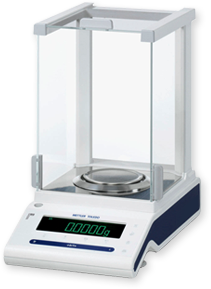What is an Analytical Balance?
 Analytical balances are precision measuring instruments used in quantitative chemical analysis, to determine the mass of solid objects, liquids, powders and granular substances. Today, electronic balance use the principle of magnetic force restoration, offering readability up to .0001 g.
Analytical balances are precision measuring instruments used in quantitative chemical analysis, to determine the mass of solid objects, liquids, powders and granular substances. Today, electronic balance use the principle of magnetic force restoration, offering readability up to .0001 g.

Industries That Use Analytical Balances
The precise measurements offered by an analytical scale makes it a critical piece of equipment for any sector that relies on quantitative chemical analysis. They are available in various shapes and sizes and can display readouts in various units, making them suitable for a wide range of industry applications.
These include pharmaceutical, food, plastics and chemical manufacturing, quality assurance labs and calibration laboratories, etc. No matter what type of analytical method you use, analytical balance precision and accuracy are essential for weighing samples as well as reagents for solution preparation.
Using an Analytical Balance
- The first step is to prepare the balance for weighing your sample, by leveling and zeroing it. Check whether the leveling bubble on the weighing chamber’s floor is centered, or adjust the leveling screws located underneath. Then, close the chamber doors and briefly press down on the control bar till a row of zeros is displayed.
- Solid objects can be weighed directly on the balance pan, by opening the chamber doors and placing the object on the pan. The readout will be displayed after you close the doors.
- Use the appropriate container for weighing liquids, powders, or granular substances. Start by placing the container on the pan and zeroing the balance. Then, carefully add the sample (either directly, or by removing the container and making sure the control bar is untouched), close the doors and check the readout.
- If any chemicals have spilled on the balance, it should be cleaned thoroughly. Shut it down (by gently raising the control bar) after you’re done using with your weighing procedures for the day.
Best Location for an Analytical Balance
These sensitive devices are easily affected by air currents, temperature and other physical variables, so they are enclosed or shielded to reduce exposure. Still, the enclosures will not be able to protect them completely.
Physical Influences and Calibration
Analytical balance readouts can be affected by changes in the sample and/or container as well as other physical influences.
- Use clean and dry containers for samples, and avoid beakers with large or wide openings. Pick the smallest container possible, and cover it if needed.
- Condition the sample/container to the prevailing temperature, to avoid issues with repeatability and weighing results. You may also find drifts in the readout value (even with a stable display when the balance isn’t loaded) otherwise.
- Evaporation may occur in uncovered samples/containers, or they may absorb water if handled with bare fingers. Readouts could increase or decrease continuously, or you may find drift (even with a stable display when the balance isn’t loaded).
- Electrostatically charged samples/containers (e.g. glass or plastic) or very low humidity may cause non-repeatable values or drifts in one direction. Shield the sample with metal foil or a metal container, increase the humidity and neutralize static electricity with an ionizing blower.
- Magnetic force fields can lead to stable but non-repeatable values, or changes in display based on the sample’s position. Avoid using magnetic stirring bars, shield samples with Mumetal foil or non-magnetic objects, use anti-magnetic weighing pans and demagnetize the pan before weighing.
To maintain analytical balance accuracy, it’s important to calibrate it on a regular basis.
- If your balance offers an internal calibration feature that requires minimal user input, follow the manufacturer’s instructions and use this feature regularly. However, if quantitative chemical analysis plays a critical role in your industry (e.g. food or pharma), conduct your own tests as well.
- The appropriate calibration settings for a certain environment can be determined with certified calibration masses, which is especially crucial when you’re calibrating sensitive instruments like analytical balances.
-

It’s a good idea to set up a regular calibration schedule, so your balances can be tested for accuracy every few months. Also, make sure to recalibrate them in case of any environmental changes (e.g. relocating the device).
Call us @ 800.722.5301 for
Reliable installation and accurate calibration of all types of weighing solutions.





